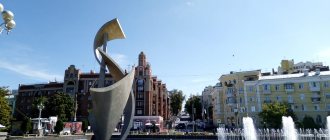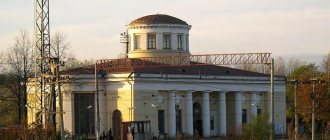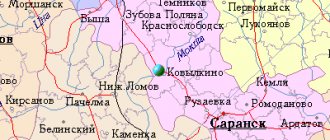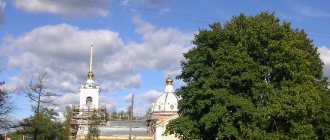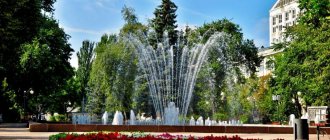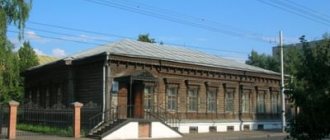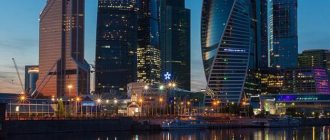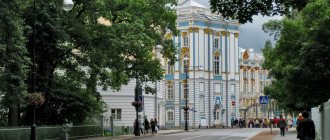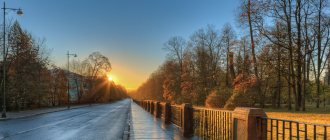It borders on the Petrodvortsovo, Moskovsky, Kirovsky districts of St. Petersburg and the Gatchina, Lomonosovsky districts of the Leningrad region.
According to official data as of January 1, 2019, the population here is 397,609 people. Driving along Peterhofskoe Highway, you will certainly notice the huge shopping complex “Pearl Plaza” and new houses in pleasant warm colors - the residential complex “Baltic Pearl”. This is the Krasnoselsky district of St. Petersburg - an actively developing area in the southwest of the city with an area of about 115 square meters. km.
History and general information
Krasnoselsky district is an actively developing area of St. Petersburg in the South-West of the city.
Krasnoselsky district is located in the South-West of the city and borders the Petrodvortsovo, Moskovsky, Kirovsky districts of St. Petersburg and the Gatchina, Lomonosovsky districts of the Leningrad region. The territory of the Krasnoselsky district is about 114 square kilometers. The water system of the Krasnoselsky district is formed by natural structures combined with artificial human structures. The Liga (the old name is the Dudergofka River) and Ivanovka rivers flow through the region, there are lakes of artificial origin - Dudergofskoye, Bezymyanny and Dolgoye, as well as the Matisov Canal, the Peterhof collector and the coast of the Gulf of Finland.
The Krasnoselsky district owes its name to the city of Krasnoe Selo, built during the reign of the great Emperor Peter I. During the reign of Peter I, the current territories of the Krasnoselsky district were covered with forests, among which many dachas, country residences of the emperor and his courtiers were built, orchards and parks were laid out. . The city of Krasnoye Selo first belonged to Catherine I, who began the development of the territories. Later, the land passed to Elizabeth, the daughter of Peter I. It was under her that the city began to be called “The Palace Village of Krasnoe.”
Thus, the southern coast of the Gulf of Finland, due to its appearance and location on a coastal ledge, became the main entrance to the capital of a great power. Peter wanted to show the power and beauty of his city, which would be visible to guests approaching by sea from all over the world. During these years, St. Petersburg became the capital and the imperial court moved to it, which led to the growth and intensive development of the city. In 1911, plots of land of 1000×1000 fathoms from Ekateringof to Oranienbaum were distributed to the courtiers. The plots were located on a hill, which allowed travelers to admire the beautiful estates located along the coastline from afar. Some of the first travel palaces were built, including Petrov Dvor (present-day Peterhof) and a small estate at Cape Strelino, where the Emperor stopped to rest after the journey.
Krasnoselsky maneuvers
In 1925, the settlement of Krasnoe Selo was given city status. The battles of the Great Patriotic War were fought on the territory of Krasnoe Selo. It was with the capture of this settlement that the operation to lift the blockade of Leningrad began.
In the post-war years, work was actively carried out to restore the area, the city of Krasnoe Selo was completely rebuilt. Leningrad began to expand, large-scale housing development was underway, so it was necessary to reorganize the administrative division and create new districts, which included territories whose development was planned in the future. According to the Decree of the Presidium of the Supreme Soviet of the RSFSR dated April 13, 1937, the Krasnoselsky district was formed, in which 176 thousand people lived, and twenty schools and nineteen kindergartens were located. Krasnoselsky district has become one of the most populated and largest in St. Petersburg.
Krasnoselskaya Holy Trinity Church
Holy Trinity Church is the symbol of the city. A bright and elegant building in the early Baroque style, it stands out against the background of the utilitarian architecture of Krasnoye Selo. The church reminds of the distant past of the city. It is considered one of the oldest churches in St. Petersburg, as it was first built and consecrated in 1735.
The church is active, services are regularly held there, and it is open to the public. At the entrance there is a memorial plaque about the bookmark. For a long time the building was under reconstruction, but now you can get there and appreciate for yourself how spacious, intimate and cozy it is inside.
Location: Lenin Avenue - 108.
Ecological situation
One of the indisputable advantages of the Krasnoselsky district of St. Petersburg is the favorable environmental situation. Krasnoselsky district is considered the most environmentally friendly district of St. Petersburg. The good ecological situation in the Krasnoselsky district is ensured by a combination of factors, among which the leading role is played by a large number of green spaces, as well as the relatively clean activity of industrial enterprises.
Enterprises of the Krasnoselsky district - Staropanovsky Building Structures and Materials, Piter-Lada, Aviaremontny, Ferropribor, Svetoch and others do not produce large amounts of harmful emissions that seriously pollute the environment. The main amount of pollutants is brought from the territory of the neighboring Kirovsky district, in which a large number of large industrial enterprises that produce harmful emissions into the environment are concentrated.
Novoznamensky Park
On the territory of the Krasnoselsky district of St. Petersburg there are separate zones with unfavorable environmental conditions associated with the presence of hazardous industries in the past or present. Thus, soils near the former Coal Harbor landfill and areas located north of the Peterhof Highway are considered contaminated. The soils are contaminated with petroleum products and benzopyrene, the concentration of which is 2–3 times higher than the maximum permissible concentration. However, even this level of soil pollution is low compared to other areas of the city.
Bridge over the Liga River
A large number of reservoirs are located in the Krasnoselsky district, but their degree of pollution is higher than that of air and soil. Thus, ponds located along the Peterhof Highway and on the territory of the South Primorsky Park, as well as the Ivanovka and Sosnovka rivers, are assessed by ecologists as “polluted.” The League River and the Duderhof Canal are “dirty”. These reservoirs contain high concentrations of manganese, iron, E. coli, as well as pathogenic microbes that cause dangerous infectious diseases. Sources of pollution of water bodies of the Krasnoselsky district are wastewater from residential areas, horticultural societies and industrial enterprises. All other reservoirs of the Krasnoselsky district of St. Petersburg, with the exception of lakes Bezymyanny and Dolgoye, are clean, which allows swimming in the warm season.
The noise level in the Krasnoselsky district does not exceed the norm. Only Veteranov Avenue and Marshal Zhukov Avenue have a stable high noise background, which is created by vehicles moving along the Peterhof and Tallinn highways.
The radiation background of the Krasnoselsky district is heterogeneous, and there are about 20 areas of radioactive contamination, which is directly related to the work of industrial enterprises, four of which use radioactive elements and substances. The largest area of radioactive contamination is located south of the municipality of Gorelovo and continues to the border of the Leningrad region. In addition to industrial enterprises, the radiation background in the Krasnoselsky district is created by natural sources - radioactive rocks that come to the surface. Due to these circumstances, the radioactive situation in the Krasnoselsky region is classified as “complex”.
Population of the area
Dancers work for residents of St. Petersburg
Previously, the shores of the Gulf of Finland, including the Southern Gulf, were inhabited by Finnish tribes, among which the most famous are the Vod and the Inkere people. The Novgorod Slavs settled next to them. This cohabitation of different ethnic groups led to the appearance of mixed names for the territories of the region and its environs.
Currently, the population of the Krasnoselsky district is more than 300 thousand people. The age composition of the population is heterogeneous and is represented overwhelmingly by middle-aged people and children of preschool and school age living in new neighborhoods. There are relatively few people of retirement age, and they live in parts of the area with old buildings or in the municipalities of Gorelovo, Uritsk and others, as well as in the city of Krasnoye Selo.
Last bell in schools
Active development of the area contributes to its settlement by young couples with children, who can increasingly be found on the streets. It is also quite common to meet immigrants from other countries who came to earn money by working on the construction of new residential areas. These people either live on the sites under construction or rent housing.
In the future, according to experts, the Krasnoselsky district will be inhabited mainly by middle-aged people with average incomes, as well as young people.
In the Krasnoselsky district, a very small part of the population consists of entrepreneurs, which is due to the peculiarities of the infrastructure and economy of the region.
Leisure
Active recreation with the whole family in the Krasnoselsky district is possible both in winter and in summer. In winter, you can go to Orekhovaya and Voronya mountains, where you can ride cheesecakes, skis and ice skates. In summer there is a great opportunity to relax on the banks of numerous ponds, rivers and the Gulf of Finland.
Recently, the Baltic Pearl began work on improving the embankment. Next year, the district administration plans the same work on the other side of the Matisov Canal. A street promenade with paths, benches and green spaces will appear in the Krasnoselsky district.
There are sports sections and clubs of various types scattered throughout the area, for youth, teenagers and adults. There are quite a lot of small cafes, there are restaurants, a couple of cinemas and museums.
Local residents' opinion
We conducted a survey of local residents in our group. In general, almost everyone likes the area. Of the minuses, the most often mentioned is the lack of a metro and traffic jams. The advantages include parks, proximity to the bay, many shops, cozy courtyards, a sufficient number of schools and kindergartens.
Municipal division of Krasnoselsky district
Krasnoselsky district includes seven municipalities:
Map of Krasnoselsky district
- municipal district Sosnovaya Polyana (formerly municipal district No. 39);
- Municipal District South-West (formerly Municipal District No. 37);
- the city of Krasnoe Selo;
- Uritsk municipal district;
- municipal district of Gorelovo (formerly municipal district No. 42);
- Municipal District of Yuzhno-Primorsky (formerly Municipal District No. 38);
- municipal district of Konstantinovskoye (formerly municipal district No. 41).
Entrance to Krasnoselsky district
A significant part of the housing stock of the Krasnoselsky district is represented by post-war buildings. The old housing stock consists of “Stalin” buildings located along the entire length of the Peterhof Highway and block “Khrushchev” buildings. These post-war buildings are low-rise and in the vast majority of cases have only 2-3 floors. The housing stock mainly consists of more modern panel houses, which is associated with more active development of the Krasnoselsky district in the seventies of the last century.
There are approximately 5.5 thousand buildings in the district’s residential stock (“Khrushchev”, “ships”, “Brezhnevka”, “Stalinka”, brick houses and houses of the 137 series), but this figure is not constant, since the area is being built up with houses of improved layout and elite housing. In recent years, development companies have launched housing construction on a large scale throughout the Krasnoselsky district. The reclamation of soil in the wetlands of the Neva Bay created excellent preconditions for the creation of the Yuzhno-Primorsky Park and new microdistricts. Construction is still ongoing in this neighborhood and the area is growing.
In the Krasnoselsky district, real estate on the streets of Marshal Zhukov, Govorov and Marshal Kazakov is highly valued. Prestigious housing is considered to be houses on Avangardnaya and Partizana Germana streets. “View” apartments are located on Nagornaya Street, as it is located on a hill that has a sharp slope towards a green, extensive park area.
Conventionally, the territory of the Krasnoselsky district is divided into two parts - urban and suburban, the border between which is the ring road. Before the Ring Road there are “urban” territories – South-West and Sosnovaya Polyana. Outside the ring road there are “suburban” parts - the city of Krasnoye Selo, the municipality of Gorelovo and the village of Khvoyny.
The problem of the housing stock of the Krasnoselsky district is the imbalance of the market, where high supply does not correspond to low demand. As you move away from the metro station, demand progressively decreases. Due to the distance from the city center, average real estate prices in the Krasnoselsky district are lower than in other areas of St. Petersburg.
The cost of 1 m2 of real estate in the Krasnoselsky district varies from 44 thousand rubles to 81 thousand. The price depends on the location of the residential property: city limits, distance from the metro, transport development.
The variety of real estate prices in the Krasnoselsky district is very large due to differentiation into urban and suburban parts: the cost of a one-room apartment on Leninsky Prospekt in a newly built building and similar housing in the city of Krasnoye Selo differs several times. For example, a one-room apartment in the city of Krasnoe Selo costs about 1.7 million rubles, and a one-room apartment at the intersection of Brestsky Boulevard and Leninsky Prospekt (about 10 - 15 minutes by public and commercial transport to the Leninsky Prospekt metro station) - from 3. 9 million rubles. Two-room apartments cost 1-2 million more.
According to data for 2012, in the Krasnoselsky district of St. Petersburg, one square meter of residential real estate costs an average of 76 thousand rubles. The most expensive are recently erected brick-monolithic houses, in which the cost of 1 m2 is about 80 thousand rubles. The cost of 1 m2 in panel houses built from the 80s of the last century to the present day averages 77 thousand rubles.
Complex "Baltic Pearl"
The upcoming transformation of the Krasnoselsky district depends on the state of the Baltic Pearl housing project and the extensive development that is underway at the very beginning of Leninsky Prospekt. Such projects, according to experts, can give a strong impetus to the development of the South-West of St. Petersburg, as well as provide the necessary road system and developed infrastructure. In their opinion, these are the prospects for the next five, and maybe more, years. Forecasts for the future development of real estate in the Krasnoselsky district are also closely interconnected with the necessary renovation of Soviet-era buildings.
District infrastructure
The favorable environmental situation and low crime rate of the Krasnoselsky district are complemented by a well-developed infrastructure that continues to develop.
There are also several emergency medical care centers, antenatal clinics, a maternity hospital, clinics, hospitals for adults and children, as well as dental, veterinary and private medical institutions. Access to medical care is also an important factor for a comfortable and relaxing stay. In the Krasnoselsky district of St. Petersburg there are a large number of medical institutions where the population can receive qualified care. In case of emergency, the hospital is close, which allows the patient to be transported as quickly as possible. The maternity hospital allows women to give birth close to home, which is undoubtedly convenient and practical.
Hospital with modern equipment
On the territory of the Krasnoselsky district there are a sufficient number of schools, lyceums, gymnasiums, orphanages, language centers, kindergartens, music schools and libraries. These sociocultural objects create an environment that allows you to fully study, work or spend free time. Schools and additional educational institutions allow the child to master the curriculum, as well as gain additional knowledge that will help him become as competitive as possible in the future in the labor market and get a good job.
Along a small part of Leninsky Prospekt there is a building in the shape of a ship - the St. Petersburg State Maritime Technical University (SPbSMTU, popularly known as “Korabelka”). "Korabelka" is a popular and prestigious educational institution.
The Krasnoselsky district has a well-developed network of food stores: Okay Express, Pyaterochka, hypermarkets Karusel, Perekrestok, Lenta. Large retail chains in the Krasnoselsky district are represented not only by food stores, but also by hypermarkets of building materials - “Maxidom” and “Metrika”. There are also specialized large stores of electronics and household appliances with a wide range of goods - M-Video, Eldorado, Yulmart and others.
In addition to large retail chains, where it is convenient to make weekly purchases for the whole family, there are a large number of convenience stores that have a different range of goods. In the Krasnoselsky district you can buy goods for animals, household products, plumbing fixtures, furniture, carpets and other household goods.
In addition, in the Krasnoselsky district there are beauty salons for men and women, as well as for animals. Sewing studios will help you realize your fantastic ideas in clothing. In the Krasnoselsky district of St. Petersburg there are many shoe repair shops, which allows you to choose the appropriate option. Excellent consumer services for the population make life comfortable and avoid having to travel to other areas to receive various household services.
There are also enough large shopping centers, both in the Krasnoselsky district itself and in the neighborhood: “French Boulevard”, “Fiolent”, “Narvsky”, “Continent”, “Torgovoe Pole”, etc. A shopping and entertainment center is planned to open in the near future.
TRC Fiolent
Shopping complexes have good transport accessibility and a wide range of shops, restaurants and entertainment venues. Some of them have cinemas. In almost every store you can find any goods: from small items and groceries to electronics. Cafes in shopping centers offer a variety of dishes, convenient options for a snack or lunch, which allows you to actively use the services offered during your work break. Cinemas in shopping centers are well heated, allowing you to enjoy watching movies in comfortable conditions.
In the Krasnoselsky district there are many gyms and fitness centers that offer a wide range of services to suit the most demanding tastes. Anyone can choose the type of physical activity that is most suitable for them, taking into account affordability and proximity to work or home. The most elite club is Alpha Wellness, opened this summer.
A fairly high level of development of consumer infrastructure is combined with a poor transport network. The transport network of the Krasnoselsky district has distortions, which is reflected in good transport connections within the region and the difficulty of moving to another district of St. Petersburg. Communication with the city center is extremely difficult. The worst situation was found in the southern microdistricts, which are located away from the metro.
In principle, not a single line passes through the Krasnoselsky district, and the nearest stations are “Leninsky Prospekt”, “Prospekt Veteranov” and “Kirovsky metro”, which means that residents of the Krasnoselsky district have to travel through it only by public transport and commercial minibuses . Having a personal car does not help the situation, since during rush hour there are large traffic jams as the road is heavily congested.
The opening of the first metro station in the Krasnoselsky district is planned for 2022. The station will be called “Yugo-Zapadnaya” and will be located at the intersection of Marshal Zhukov Avenue and Marshal Kazakova Street. This will serve as the beginning of the development of the Krasnoselsko-Kalininskaya metro line.
Today, the transport system of the Krasnoselsky district is represented by twenty city and sixteen suburban bus routes, seven tram routes and commercial minibuses. In the future, it is planned to open above-ground metro stations, which will significantly ease the situation on the region’s roads and relieve congestion on transport routes.
The main transport routes are divided into the northeastern part - Veterans Avenue, Peterhofskoe Highway, Leninsky Avenue, Partizan German Avenue; in the municipality of Volodarsky - Volkhonskoe highway and International street; in the municipality of Gorelovo - Kommunarov Street and Tallinn Highway; in the city of Krasnoe Selo - Lenin Avenue.
The Krasnoselsky district is connected to the Kirovsky district through Stachek Avenue, Petergofskoye Highway, Leninsky Avenue, Marshal Zakharov Avenue and Marshal Kazakova Street, and to the Petrodvortsovo district via the Volkhovskoye Highway and Zheleznodorozhnaya Street.
Businesses and work in the area
Krasnoselsky District Administration building
On the territory of the Krasnoselsky district there are twenty-six large industrial enterprises, one scientific, eight construction, three transport and three housing and communal services enterprises.
The largest industrial enterprises of the Krasnoselsky district of St. Petersburg include - , "LEMZ", the associations "LenBytKhim", "Kontakt" and "Komplekt", Krasnogorod paper and pulp mill. In addition to their main activities, Elektronmash and LEMZ rent out the areas of their buildings.
The following research institutions are located in the district: Research Institute of Vaccines and Serums, Research Institute of Transport Engineering and Research Institute of Automation of Industrial Building Materials.
The main tax payers in the region are the following economic agents: ZAO OKS 01, OAO LEMZ, ZAO ELSI, OOO Ravioli and ZAO Chipita St. Petersburg. The listed enterprises of the Krasnoselsky district provide the largest portion of tax revenues to budgets of all levels. Every year, in addition to the above-mentioned enterprises, Petro LLC, Ferropribor OJSC, ERMZ Spetstrans OJSC, Petroneftspetskonstruktsiya CJSC, Branch, as well as Neva-Ferit LLC are achieving greater success in increasing production volumes. and JSC NPP Raduga.
Petro LLC dominates among manufacturing enterprises. The company's turnover is slightly more than 23 billion rubles, the average number of employees is two thousand people.
The above enterprises are the main employers for the population of the Krasnoselsky district. Many of them maintain apartment-type dormitories at their own expense, where housing is provided to enterprise employees. Typically, dormitories are located in a protected area, within easy reach of the metro or public transport leading to the metro station. Due to the fact that there are very few offices and business centers in the area, many people go to work in other areas of the city.
WWII monuments
Krasnoye Selo was occupied and suffered greatly during the Great Patriotic War, so the monuments to its heroes deserve special mention.
The memorial " Mass Grave of Soviet Soldiers " is located in the Palace Park. Since 2010, an eternal flame has been burning at the memorial of the year. Above the fire there is a monument to the unknown soldier, and next to it there are signs on which are engraved the names of soldiers who died in battle. The memorial is located in the area of the broken blockade ring. On memorable dates, residents bring wreaths and fresh flowers to him.
Prisoners of Nazism was opened in 2009 . The memorial was created in the form of a granite stele, inside which is the figure of a child and figurative figures of those who were not destined to return.
The “Grieving Mother” monument is dedicated to mothers who did not receive their sons back from the war. They never believed in the death of their sons and always waited, even when the war was long over.
Criminal situation
Regarding the criminal situation in the Krasnoselsky district, we can say that it is relatively prosperous, and the district does not lead in the dubious championship of St. Petersburg in terms of the number of offenses. The criminal situation in each individual area is determined by several factors, among which the main role is played by the location, infrastructure, mentality and traditions of the population, but also, of course, the peculiarities of the work of local police units. Krasnoselsky district is one of the last places in the “criminal rating” and is considered quite safe.
Police Department
Today, problematic offenses in the Krasnoselsky district are car thefts, especially often committed from new microdistricts with newly built residential complexes. To stop these offenses and increase their detection rate, outdoor surveillance cameras are being installed in the Krasnoselsky district today.
New police car
Meanwhile, a number of high-profile crimes were committed in the area, which received wide public attention. Most recently, in June 2012, an entrepreneur, the general director of one of the commercial firms in St. Petersburg, was killed. A forty-year-old businessman was engaged in transactions with rolled metal. Today the Investigative Committee believes that the murder was committed due to the professional activities of the entrepreneur. The Fontanka publication reported that the murdered businessman was the head of the group, which was founded in 2007. "Vostok" was engaged in the production and processing of galvanized steel and various grades of coated steel, and the company's sales and representative network covers almost the entire territory of Russia from Yakutsk to St. Petersburg.
In 2008, in the Krasnoselsky district of St. Petersburg, Dmitry Marininov, an employee of the main department of internal security of the Investigative Committee under the Russian Prosecutor's Office, who was investigating the crimes of the Kirilchuk gang, who previously worked in the police, was killed. According to law enforcement agencies, Kirilchuk was engaged in criminal activities in the Krasnoselsky district of St. Petersburg. Having learned about the development of his criminal group by police officers, Kirilchuk “ordered” the murder of Marininov. The investigative team conducted searches of Kirilchuk’s gang members and seized drugs, weapons and ammunition, as well as evidence of the gang’s involvement in the murder of investigator Marininov. Presumably, an executor was hired to deal with Marininov, who has not yet been found.
The well-known journalist A. Khinshtein published information according to which investigator Marinov himself was involved in the activities of criminal groups and even bore the nickname Marina. Khinshtein put forward a version that the investigator was killed as a result of an erupted conflict with a drug dealer, who was a Gypsy baron by origin.
The Krasnoselsky district was not spared the sad crimes associated with the attempt to get rid of the child. So, on August 17, a newborn baby was found in the bushes near the road, covered with a plastic bag. The child was alive, he was placed in a children's hospital under the supervision of doctors. It has not yet been possible to locate the mother or father, and the prosecutor's office is conducting investigative measures.
Sights of the area
In the Krasnoselsky district there are a number of attractions: the Walk of Fame of the Second World War, the Walk of Fame of sports stars, the Duderhof Heights and Nagorny Park in the village of Mozhaiskoye, the Anna Akhmatova “Silver Age” museum.
The Duderhof Heights are hills of glacial origin, consisting of the Orekhovoya and Voronya mountains. Orekhovaya Mountain is the highest point (176 meters above sea level) in St. Petersburg. There is a beautiful park on it, where the building of a former hospital, the ruins of nursing homes and a bread house, an old cemetery, and a monument to the cruiser Aurora are located. Mount Voronya (147 meters above sea level) offers an amazing view of the city. The Duderhof Heights are included in the register of World Importance, and the Nagorny Park in the village of Mozhaisk received the status of a cultural and natural monument for its unique vegetation.
Obelisk, Duderhof Heights
Monument to the cruiser "Aurora", Dudergof Heights
Krasnoselskaya Holy Trinity Church is one of the oldest in St. Petersburg. It was founded in the city of Krasnoye Selo by order of Anna Ioannovna. The temple survived all military events in the history of our country and the years of Soviet rule. In 1995, the Krasnoselskaya Holy Trinity Church was included in the number of objects of cultural and historical heritage, as an architectural monument of federal significance. The church runs a Sunday school for children and publishes its own parish newspaper, “Svecha.” Today, the Krasnoselskaya Holy Trinity Church is the central church of the Military Deanery of the St. Petersburg Diocese.
Holy Trinity Church after the liberation of the occupied territory
Holy Trinity Church, Krasnoye Selo
The Anna Akhmatova Silver Age Museum was opened 26 years ago and is dedicated to the great poetess and the Gumilev family. The museum has 9 halls: “Tsarskoe”, “Slepnevo”, “Stray Dog”, “The Journey of N.S. Gumilyov", "Petersburg", "Requiem", "Komarovo", "Poem without a Hero", "Memory Room", which are arranged in chronological order. In the museum you can admire rare exclusive portraits of Anna Akhmatova and Nikolai Gumilyov, furniture, porcelain, books with their autographs and books from their personal library.
There are also two Walks of Fame in the Krasnoselsky district. One of them is dedicated to the heroes and events of the Great Patriotic War. Today, residents of the area come here to honor the memory of the people who gave victory, and bring their children with the goal of introducing them to the history of the country and instilling the spirit of patriotism. On this alley there are monuments to the defenders of Leningrad and an obelisk erected at the line where Leningrad troops “stopped the German hordes and took up an indestructible defense.” Every year, the Alley hosts a reconstruction of the fighting of the Great Patriotic War.
The second Walk of Fame was inaugurated in September 2010 and is dedicated to sports stars of the USSR and Russia. The alley is located on the territory of Lyceum No. 509 of the Krasnoselsky district and consists of ten stars on which are engraved the names of great athletes who at different times glorified the national sports school.
Monument to the Defenders of Leningrad on the Walk of Fame of the Krasnoselsky District
Obelisk to the Defenders of Leningrad, installed on the defense line. Krasnoselsky district, Walk of Fame
Park "Krasnoe Selo" (Palace)
The park is located between Lenin, 1st May and St. Equalities. Today it is a landscaped area with beautiful ancient trees and alleys for walking. It has paths for walking and cycling, and areas with benches.
There is an open stage at the top of the park. It hosts city holidays and events. Over the course of its history, the park has changed 5 names and has changed a lot. At different times, it housed seven royal palaces; unfortunately, they have not survived to this day.
